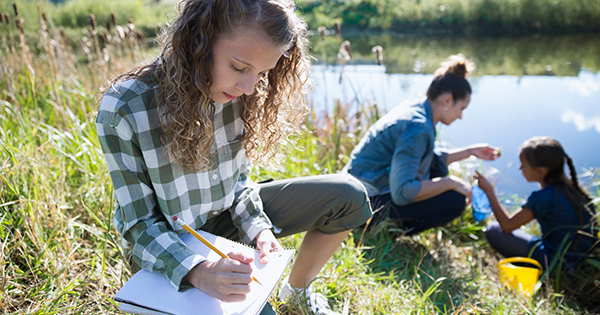
Leah McDermott, MEd, contends that children are spending less time in the outdoors or in the arts (music, art, band, etc.) because schools are devoting more time to test prep.
She wants that to change.
“Despite everything we know about the amazing benefits of children spending time outdoors in free, physical play every day, the trend has been to take that away more than increase it,” McDermott said. “So our elementary educators who are up-to-date on their research know that their kids need to be outside more often, but they are met with the struggles of fitting this into their rigid schedules.”

Leah McDermott developed a program to encourage schools to help students engage more with nature.
McDermott, who hails from the Pacific Northwest and has 13 years of teaching experience, wants teachers and administrators to start talking about getting kids outside and bringing nature inside. Since 2009, she’s been working to make it happen with a program she developed called Your Natural Learner, which provides training and one-on-one services that help educators, schools and early childhood centers bring more nature-inspired learning into their classrooms.
Recess is not enough exposure to nature
McDermott is bringing nature into the classroom because the typical school day schedule does not allow for much time outdoors other than recess — which is dwindling in schools across the country already.
Educators who use her program learn how to swap harsh fluorescent lighting for more natural lighting to enhance visual performance and encourage better social behaviors. “They learn of the best plants to bring indoors to clean the air, act as soundproofing and provide a calming feel to the space. These schools work to bring natural elements to their student’s daily work to enhance discovery, creativity and problem-solving skills,” she said.
McDermott says she has received strong feedback from educators. “These teachers report that after implementing my strategies, children work better and more peacefully in pairs and individually, the children seem more excited to participate in work that incorporates the natural elements, and their classrooms feel significantly more comfortable and safe, providing a better overall learning experience not just for the students, but for the teachers as well,” she said.
McDermott’s strategies help teachers shift their own mentalities about what a classroom should look and feel like, and how they can benefit from day-to-day interactions with nature.
“Obviously everyone has access to nature, so it’s nothing groundbreaking or new by any means, but I believe that my method of implementing new habits and changing the way we view our current surroundings is something many teachers have either never been taught or haven’t ever considered,” she said.
McDermott says she hopes to work with teachers at 25 schools this year and would like to see her program go nationwide eventually.
How teachers can connect kids with nature
McDermott offered these tips for elementary school teachers who’d like to integrate more nature into their day-to-day work:
- Get outside as much as you can. Don’t think of recess as your only opportunity. “Could your kids all grab their favorite book and do reading time outdoors? Can you do math with chalk on the sidewalks? Think outside of the box a bit and find as many ways as you can to get outdoors each day,” she said.
- Bring nature indoors. Increase your natural light and try to avoid fluorescent lighting. Take down heavy curtains, open the blinds, use mirrors to bounce light around and add a light-colored area rug. Brighten that space up!
- Add plant life. Choose easy-to-care-for plants that can stay in a classroom for long weekends without care, such as spider plants, rubber plants, succulents, aloe, etc.
More than anything, McDermott thinks we need a shift in the adult mindset. Get creative with your thinking, and even invite your students to join the conversation on how to bring more nature to your classroom environment.
Categorized as: Teacher Recognition
Tagged as: Physical Education and Health, Professional Development, Teacher Leadership
